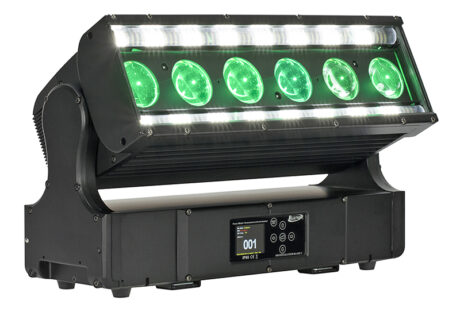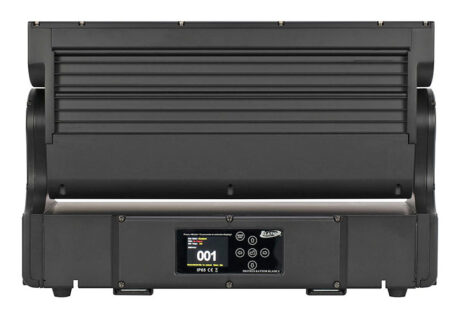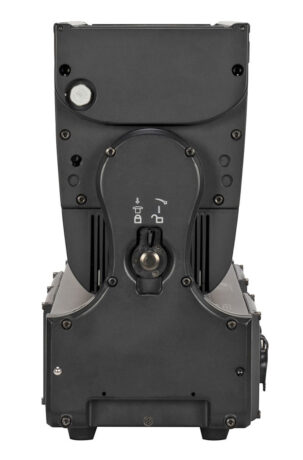
This month’s Road Test was conducted by Lighting Director/Programmer/and Lighting Design Professor, Kevin Lawson. Along with his freelance career he also teaches at the University of Cincinnati College-Conservatory of Music in its Lighting Design and Technology program. [In fact, he was joined by several of his lighting students at CCM in putting this new product—the Elation Proteus Rayzor Blade S luminaire—through its paces.]
The Proteus Rayzor Blade S is an interesting combination of linear wash and high intensity strobe, along with adding Elation’s patented SparkLED™ system, all built into a compact IP65 rated linear fixture. With a wide, zoom range from 6˚ to 45˚, it creates well-defined mid-air beams and light curtains with over 6,600 lumens output as well as wide and even wash coverage. The light includes two seamless high-intensity strobe lines with a total of 128 cool white LED dots that flank the Rayzor lenses across the entire length of the fixture. The front lenses create a large visual surface on the fixture enhanced by the exclusive patent pending SparkLEDs technology. SparkLEDs consists of individual white LEDs, placed inside the lens itself to create an additional layer for depth. SparkLEDs are controllable by the console or driven by a variety of internal FX patterns. The light is protected from dust and water ingress and is part of Elation’s Proteus range of outdoor luminaires. The Rayzor Blade S is 19.8” in length and a larger version, the Rayzor Blade L measures 39.5” in length is also available.
Here are Lawson’s thoughts on the Proteus Rayzor Blade S:

Set Up
The fixture is just under 2’ long so at 39 lbs. it feels a bit “beefy” when I pulled it out of its box. It has hand holds on the side of its base which make it more manageable for one person to lift. It may be a bit heavy for its size, but it packs a lot of punch in that small body. It ships with omega brackets for hanging with clamps or it can sit on its feet under the base.
The Rayzor Blade was generally easy to set up. Elation’s menu system is clear and easy to navigate. It does require a 10 sec. button press to unlock the touch screen, which might be annoying if I was in a less comfortable position trying to access the unit. [Ed. note: Elation states, “The 10 second menu hold is also intentional to avoid the menu unlocking when water settles on the touch display when used outdoors in the rain.”] Many settings are also available to change via RDM, so it’s a minor inconvenience at worst.

Two Fixtures in One
The Rayzor Blade is in essence two familiar fixture types in one. Its component fixtures are ones we have seen before, but Elation does an excellent job of combining them. Fixture one is an LED strip light with DMX controlled tilt and zoom. It has six 60W RGBW cells that are impressively bright. The Red, Green and Blue LEDs produce a beautiful range of saturated colors. Dark red and blue are still punchy and the color mixes smoothly through the cells. The white LED is a bit less impressive. It feels dimmer than its color counterparts and reads greener to the eye.
The dimming curve on the cells is lovely. There’s no pop at the bottom end in its default (S-Curve) preset curve. There are also three other dimmer curve options built into the fixture which can be set in the fixture menu and in a control channel from the console. Refresh rate is also adjustable via control channel from 900-25,000HZ. We TV folks always appreciate this functionality.
The Rayzor Blade has a full tilt range of 192˚ and it’s peppy. Its movement is fast, and it stops on a dime. We ran it back and forth in an aggressive tilt effect and it would happily land in its preset focus. With a zoom from 6˚ to 45˚ the fixture ranges from six small columnated beams to a homogenized beam that is impressively (magically?) circular. It creates an interesting effect as you slide through the zoom range to go from the small beams to one big one. I haven’t previously seen a multi cell fixture accomplish this as smoothly.
Strobe
The other major component of the fixture is its high powered white linear strobe lines. They run the full length of the fixture, above and below the RGBW cells. In larger channel modes the 16 cells in each line can be controlled individually. Giving plenty of options for effects and variety in the visual weight of the strobing. While the white cells in the RGBW portion of the light may feel a bit underpowered the strobe lines are the opposite. How bright are they? Plenty. Even though I was only testing a single fixture I was imagining the beautiful violence that could be inflicted with many more of them.
But Wait… There’s More
Fast tilting LED strip with deep color mixing and impressive zoom, check. Bright white linear LED strobe component, check.
There’s one more bonus element to the fixture. Around each of the RGBW cells are four points of individually controlled warm white LEDs that hit the lens and generate bling. Fun warm eye candy that sparkles in contrast to the cold white strobe and color mixing main cells. Elation calls it “SparkLED”, I would have gone for “Bling Master 2000,” which is probably why no one asks me to name products. But they should.
Control
The fixture has four profile modes (28/50/82/106 DMX channels). The progression is logical, stepping from its standard (28ch) mode where all its deeper features can be accessed via built in macros. Up to the extended mode which allows you to control every pixel individually.
It is noteworthy (and uncommon) that the DMX tables for the fixture are laid out in a console friendly order. All the DMX channels that deal with the “Main” fixture (Tilt, Zoom, Control, and Effect Macros) are grouped together first. Followed by pixel control for the RGBW cells, then the strobe lines, and finally the “Bling” SparkLED. This may not make a difference to most users. But when you must poke around in a fixture editor trying to make a light bend to your will it helps when the fixture is laid out this nicely.
Other Perspectives
We left the Rayzor Blade set up in our light lab for a week and several students took the opportunity to program whole songs with one light. Showing off its versatility. One light was fun, but we immediately saw the potential of having a whole linear array of them. The “oohs and aahs” were abundant when we tested its features, which is really want you want from this kind of light.
At a Glance:
A Road-Worthy Linear Wash/Strobe
The Elation Proteus Rayzor Blade is fast, bright, and packed with cool features like the SparkLED. It’s an effect-forward moving strip/strobe hybrid. The Rayzor Blade makes beautiful eye candy, but with its zoom range, also makes a decent linear wash.
Proteus Rayzor Blade S
- PROS: Feature-packed; wide zoom range—from linear to round beam; impressively bright; compact; fast; dims well, even at low end.
- CONS: The white LED feels dimmer than color LEDs and reads greener to the eye; menu touch screen takes 10 sec. to unlock.
Stats
- Light Source: RGBW w/(6) 60W Osram RGBW LED; (24) 2W White SparkLED; (128) 1W Strobe LED
- Output: 6,000 Total Lumens
- Zoom Range: 6˚-45°, Motorized
- Tilt: 192˚°
- Power: AC 100-240V 50/60Hz, 700W Max. Consumption
- Connections: IP65 5-pin XLR DMX In/Out; IP65 RJ45 Ethernet In/Out (Art-Net, sACN); and IP65 Locking Power Cable In.
- IP Rating: IP65
- Other Effects: Linear Color Temperature Presets (2,700-8,000K); 16-bit Dimming; Pixel Control; White SparkLED Lens Effect; Dual White Strobe Lines (64 pixels per side); Color Presets and Macros; Electronic Strobe; and Variable Dimming Curves
- Weight: 39.4 lbs.
- Dimensions: 19.8” L x 7.6” W x 13.2” H
Manufacturer: Elation Professional
More Info: www.elationlighting.com


